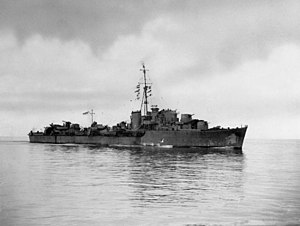 Panther coming into Hvalfjord in Iceland, January 1942
| |
| History | |
|---|---|
| Name | HMS Panther |
| Ordered | 20 October 1939 |
| Builder | Fairfield Shipbuilding and Engineering Company |
| Laid down | 15 July 1940 |
| Launched | 28 May 1941 |
| Commissioned | 12 December 1941 |
| Identification | Pennant number: G41 |
| Fate | Sunk by Aerial attack, 9 October 1943 |
| General characteristics | |
| Class and type | P-class destroyer |
| Displacement |
|
| Length | 345 ft (105 m) o/a |
| Beam | 35 ft (11 m) |
| Draught | 12 ft 3 in (3.73 m) |
| Installed power |
|
| Propulsion | 2 shafts; 2 × steam turbines |
| Speed | 36 knots (67 km/h; 41 mph) |
| Range | 3,850 nautical miles (7,130 km; 4,430 mi) at 20 knots (37 km/h; 23 mph) |
| Complement | 176 |
| Armament |
|
HMS Panther was a P-class destroyer built for the Royal Navy during the Second World War. After commissioning on 12 December 1941, she made a short trip to Iceland with the battleship King George V, then escorted a British convoy to India. In early April 1942, Panther rescued survivors from two cruisers sunk in the Indian Ocean, after which she took part in Operation Ironclad, the Allied invasion of Vichy French-held Madagascar, and sank a French submarine with another destroyer. Panther then returned to the Mediterranean, and participated in the Allied landings in North Africa, but was severely damaged in an air attack and had to undergo repairs in Gibraltar. After taking on survivors from the torpedoed SS Strathallan, Panther escorted two Allied convoys in the Atlantic. She next supported the Allied attack on Sicily, then sailed to the Aegean Sea in the Dodecanese Campaign. On 9 October 1943, Panther was sunk by German Stuka dive-bombers with 33 dead.